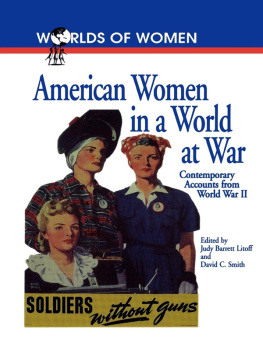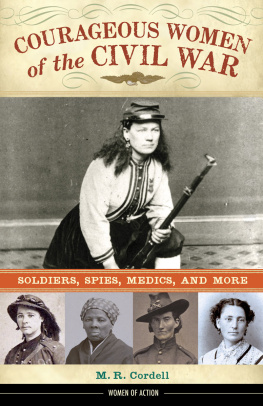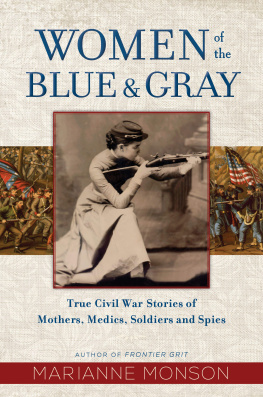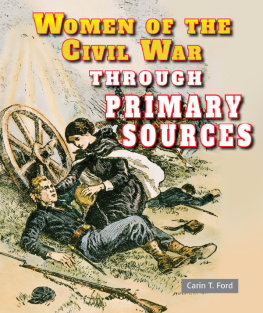ARMY at HOME
CIVIL WAR AMERICA
Gary W. Gallagher, editor
2009
The University of North Carolina Press
All rights reserved
Set in Bell
Manufactured in the United States of America
The paper in this book meets the guidelines for permanence and durability of the Committee on Production Guidelines for Book Longevity of the Council on Library Resources.
The University of North Carolina Press has been a member of the Green Press Initiative since 2003.
Library of Congress Cataloging-in-Publication Data
Giesberg, Judith Ann, 1966
Army at home : women and the Civil War on the
northern home front / Judith Giesberg.
p. cm. (Civil war America)
Includes bibliographical references and index.
ISBN 978-0-8078-3307-0 (cloth : alk. paper)
1. United StatesHistoryCivil War, 18611865
Women. 2. United StatesHistoryCivil War, 18611865
Social aspects. 3. Working class womenNortheastern States
History19th century. 4. Working class womenNortheastern
StatesSocial conditions19th century. I. Title.
E628.G538 2009
973.7082dc22
2009002898
13 12 11 10 09 5 4 3 2 1
CONTENTS
ILLUSTRATIONS
Lydia Bixbys grave, Boston, Massachusetts
Samuel and Elizabeth Schwalm
Widow Thompsons house, Gettysburg, Pennsylvania
Woman and children at camp
Rates of lodging versus incarceration for female inmates in the Boston watch house, 18611863
Massachusetts State Almshouse inmates, 18601868
Circumstances of womens incarceration at Massachusetts State Almshouse, 18601868
Allegheny Arsenal Monument, Pittsburgh, Pennsylvania
Separate spheres of arsenal work
Monument to arsenal victims, Washington, D.C.
Streetcars as moving theaters
Charlotte and Harriet Escape in Deep Mourning
The Effect of Judge Pratts Decision
Courtrooms as theater
Mammy Pleasant
Sowing and Reaping
Women in the New York City draft riots
Wartime and postwar travel arrangements
Mothers Waiting for Her Soldier Boy
The powder magazine at the former site of the Allegheny Arsenal
The scene of the 1862 Allegheny Arsenal explosion
Plaque to the Allegheny victims
Monument to Confederate Women, Jackson, Mississippi
ACKNOWLEDGMENTS
Diego deserves more credit for helping me finish this book than he knows. Are you done your book yet? he asked when I met him and his brother, Pablo, after school each day. (In the Philadelphia suburbs, no self-respecting eleven-year-oldor nine-year-old, for that mattersays done with.) And each morning, Mom, finish your book today. The time between the morning directive and the afternoon inquiry seemed long enough to him that it just didnt make sense that it was taking me so long. But as any parent of young children will tell you, on a good day you will swear that the hours before three oclock yielded only about ninety minutes worth of work, leaving you little choice but to work at night and just about every weekend. Even so, the two people who showed the least patience with this projectand who did their best to distract, interrupt, and deraildeserve thanks, at the very least for making me determined to answer, Yes, Im done my book. Thanks, Diego and Pablo, for making the school day seem so short and for filling the other days with snow tubing, boogie boarding, and all the other things that take me far away from my laptop.
I am fortunate to have generous colleaguespresent and past. Charlene Mires and Paul Rosier read most of this book at the chapter chats we have had over the past two years. They pushed me to make the book more than the sum of its parts and are largely responsible for any progress I have made in that regard. Dora Dumont read the entire manuscript, helping me with big questions and small ones, and doing more than any friend should have been asked to do. Sanjay Joshi, Paul Steege, Jeffrey Johnson, and Marc Gallicchio read pieces and offered excellent advice. Advice that Adele Lindenmeyr and Seth Koven offered on my grant applications helped me focus my thinking early on in the project. I received generous help from Amy Spare and Bernadette DiPasquale at Villanovas Law School Library, and Nicole Garafano, who is a part-time graduate student and full-time events coordinator at the law school, provided well-timed assistance. I would also like to thank Villanova Law School colleagues Catherine Lanctot and David Bogen, whose interests parallel mine and whose support for this project was welcome. I owe a debt of gratitude to Joanne Quinn at Villanovas Falvey Library Interlibrary Loan Department for leaving no stone unturned. History Department graduate students Colleen Rafferty and Karen Sause helped track down references and organize them. Dana Kellogg Repash and Chris Filiberti provided critical support at the end. Thank you to Jennifer Pohlhaus of Villanovas UNIT and Michael Foight of Falvey Library for help with the images.
Welcome financial support came from the National Endowment for the Humanities, the Huntington Library, the Massachusetts Historical Society, the Pennsylvania Historical and Museum Commission, a Villanova University Summer Research Grant, and the Department of History. Villanovas Subventions CommitteeCharles Zech, Catherine Kerrison, and John Johannescame through with support for copyrights and image reproductions.
Thanks to Elizabeth (Liz) Varon, Andy Waskie (aka General George Meade), Nilgun Okur, Stephanie McCurry, and John Rumm for welcoming me into the scholarly Civil War community in Philadelphia. I hope Liz and Stephanie enjoy our coffee klatches as much as I do, even if we never get around to talking about our research. Matt Gallman read the manuscript, offered advice and encouragement, and continues to be more generous with his time and friendship than seems possible. Gabor Boritts generosity, too, is legendary, and I have happily benefited from it these past few years. For sharing their knowledge of Philadelphias streetcar battle, thank you to Dan Biddle and Murray Dubin, whose much-awaited biography of Octavius Cato will be an excellent addition to the history of the Civil War in Philadelphia. Thank you to James Wudarczyk for giving me a memorable tour of the former grounds of the Allegheny Arsenal. If it were not for his tireless work, this important site would have been forgotten long ago. I would like to thank Gary Gallagher for expressing an early interest in the manuscript and encouraging me to submit it to UNC Press for consideration. Thank you to David Perry and the anonymous readers for providing advice and criticism.
The Pennsylvania Historical and Museum Commission (PHMC) Archives are a treasure trove for any historian interested in learning about the Civil War on the northern home front. I would like to extend my deepest gratitude to Jonathan Stayer, Linda Ries, and Richard Saylor, who helped me to find many of the commissions hidden treasures. All three wereand continue to bepatient with my frequent questions and are always cheerfully ready to help me to cross-check my facts, in person and via the Internet. It was Linda who came to me one day and said, Someday, someone needs to do something with these letters to Governor Curtin asking for money to retrieve bodies. That collection opened up a whole world for me as I tried to understand what it was like for women dealing with the loss of a soldier-relation. Linda Shopes at the PHMC and Rhonda Newton at the Pennsylvania Heritage Commission deserve thanks for helping me to think clearly about the questions I was asking early on. With cuts in state spending, everyone at the PHMC is doing the work of at least two people, yet they are always willing to help someone to whom they really owe nothing and who generally asks too many questions.






